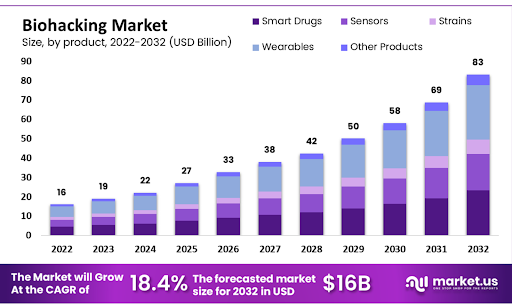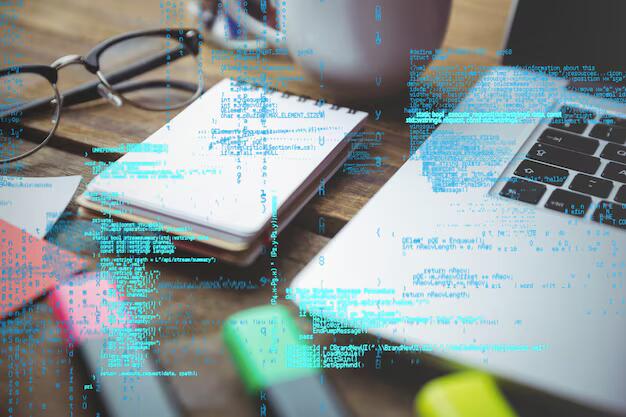Biohacking, a term once confined to the realms of tech enthusiasts and extreme health aficionados, has now become a mainstream phenomenon. In the United States, this rapidly growing market is capturing the interest of those eager to explore the limits of human potential. Whether it’s through refining diets, optimizing sleep patterns, or employing cutting-edge technology to monitor and enhance bodily functions, biohacking offers a path to personalized optimization. The market isn’t just expanding; it’s evolving, fueled by a collective drive for peak physical and mental performance. So, what exactly is biohacking, and why is it gaining such popularity? Let’s delve deeper into this intriguing trend.
What is Biohacking?
Biohacking involves making small, incremental lifestyle and dietary changes to boost health and well-being. It spans a wide spectrum of activities, from simple dietary tweaks and exercise routines to more complex interventions like genetic modifications and the use of implantable devices. At its heart, biohacking is about self-empowerment—taking charge of your biology to achieve better physical and mental performance.
This can be as straightforward as tracking your sleep and diet to see how they affect your mood and energy levels or as advanced as using CRISPR technology to modify your DNA. The essence of biohacking lies in experimentation and data-driven decision-making. Biohackers frequently use wearables and apps to gather data on their body’s performance, using this information to refine their routines. This approach aims not just to extend life but to enhance its quality, making daily activities more efficient and enjoyable. The ultimate goal is to optimize both body and mind, pushing the boundaries of human potential.
Key Drivers of Market Growth
Several factors are propelling the rapid growth of the biohacking market in the US:
- Increasing Health Awareness. A major driver is the growing awareness and interest in health and wellness. With more information available through the internet and social media, people are becoming more conscious of their health choices and seeking innovative ways to optimize their well-being.
- Technological Advancements. The rise of wearable technology has been pivotal. Devices like smartwatches and fitness trackers provide users with real-time data about their physical activity, sleep patterns, and even stress levels. This data empowers individuals to make informed decisions about their health.
- Influence of Prominent Biohackers. Influential biohackers and endorsements from celebrities and public figures have helped popularize the trend. These influencers often share their biohacking journeys and successes, inspiring others to adopt similar practices.
- Advances in Biotechnology. Innovations in biotechnology and genetic engineering are making sophisticated biohacking techniques more accessible and affordable. From personalized supplements to at-home genetic testing kits, these advancements are opening up new possibilities for the average consumer.
- Supportive Communities. The growing number of biohacking communities and online forums provide a supportive environment for enthusiasts to share experiences, tips, and advice, further fueling the market’s expansion.
Popular Biohacking Practices
Biohacking includes a diverse array of practices, each with its own tools and methods designed to enhance various aspects of health and performance. Here are some of the most popular techniques:
- Intermittent Fasting. This dietary approach involves cycling between periods of eating and fasting, believed to improve metabolic health, aid in weight loss, and boost longevity. For example, the 16/8 method involves fasting for 16 hours and eating within an 8-hour window.
- Nootropics. Also known as “smart drugs,” nootropics are substances used to enhance cognitive function, memory, creativity, and motivation. They range from natural supplements like caffeine and ginseng to synthetic compounds like modafinil and racetams.
- Wearable Technology. Devices such as fitness trackers, smartwatches, and sleep monitors provide continuous feedback on various health metrics. This data-driven approach allows individuals to make precise adjustments to their routines. For instance, tracking sleep patterns can help optimize rest and recovery.
- DIY Biology and Genetic Modifications. Some biohackers engage in more extreme practices like DIY biology and genetic modifications. DIY biology, or biohacking labs, allow individuals to conduct biological experiments outside traditional labs, often involving gene editing tools like CRISPR. While these advanced methods carry more risks, they represent the cutting edge of the biohacking movement.
More details on https://www.biohackers.world/
Benefits of Biohacking
The benefits of biohacking can be substantial and multifaceted:
- Physical Health Improvements. Biohacking can lead to better weight management, increased energy levels, enhanced athletic performance, and a strengthened immune system. By tailoring diet, exercise, and sleep patterns to one’s unique biological makeup, individuals can achieve optimal health more effectively than with one-size-fits-all approaches.
- Mental Health Enhancements. Biohacking can result in heightened cognitive function, improved focus and memory, and better stress management. Techniques like mindfulness meditation, cognitive behavioral therapy (CBT), and the use of nootropics are popular among biohackers for boosting mental performance and well-being.
- Self-Awareness and Empowerment. Biohacking fosters a deeper understanding and connection with one’s body. By meticulously tracking and analyzing various health metrics, biohackers gain insights into how different factors affect their well-being. This self-awareness can lead to more informed decisions and a proactive approach to health management.
- Community Support. The biohacking community offers a supportive network where individuals can share their experiences and learn from others. This sense of community can be empowering, providing motivation and encouragement to continue the journey towards self-optimization.
Overall, the personalized nature of biohacking allows individuals to achieve a higher quality of life by addressing their specific health needs and goals.
Challenges and Criticisms
Despite its growing popularity, biohacking faces several challenges and criticisms:
- Lack of Regulation. A major concern is the lack of regulation and oversight in the industry. Without standardized guidelines, there is a risk of individuals engaging in unsafe or unproven practices. This is particularly true for more extreme forms of biohacking, such as genetic modifications and implantable devices, which can pose significant health risks if not done correctly.
- Ethical Considerations. Ethical considerations also come into play, especially when it involves altering one’s genetic makeup or using invasive technologies. There is ongoing debate about the moral implications of such practices and their potential long-term effects on individuals and society as a whole.
- Obsession with Perfection. The pursuit of self-optimization can lead to an unhealthy obsession with perfection. Some individuals may become overly fixated on achieving certain health metrics or physical outcomes, resulting in stress and anxiety.
- Accessibility Issues. The biohacking movement has been criticized for being elitist, as many advanced techniques and tools are expensive and not accessible to everyone. This can create disparities in who can benefit from biohacking, leading to broader societal inequities.
- Information Overload. While the data-driven approach of biohacking can be beneficial, it can also lead to information overload. With so much data to analyze, individuals may find it challenging to discern what is truly important for their health.
Despite these challenges, the biohacking community continues to advocate for safer and more ethical practices, pushing for advancements that benefit everyone.
Conclusion
The US biohacking market is growing rapidly, driven by a collective desire for self-optimization and better health. While the movement faces challenges and criticisms, its benefits and potential for innovation are undeniable. As technology advances and more people embrace biohacking, the future looks bright for this exciting field. Whether you’re a seasoned biohacker or just curious about the practice, it’s an exciting time to explore the possibilities of enhancing your body and mind.
FAQs
What is biohacking?
Biohacking involves making lifestyle changes to improve health and performance through diet, exercise, technology, and sometimes genetic modifications.
Is biohacking safe?
While many biohacking practices are safe, some can be risky, especially those involving untested methods or devices. It’s important to research and consult with professionals before trying new biohacking techniques.
What are some common biohacking techniques?
Common techniques include intermittent fasting, using nootropics, and tracking health metrics with wearable technology.
Can anyone start biohacking?
Yes, anyone can start biohacking by making small changes to their lifestyle. However, more advanced techniques should be approached with caution and professional guidance.
What are the benefits of biohacking?
Benefits can include improved physical health, enhanced cognitive function, better weight management, and increased energy levels.












